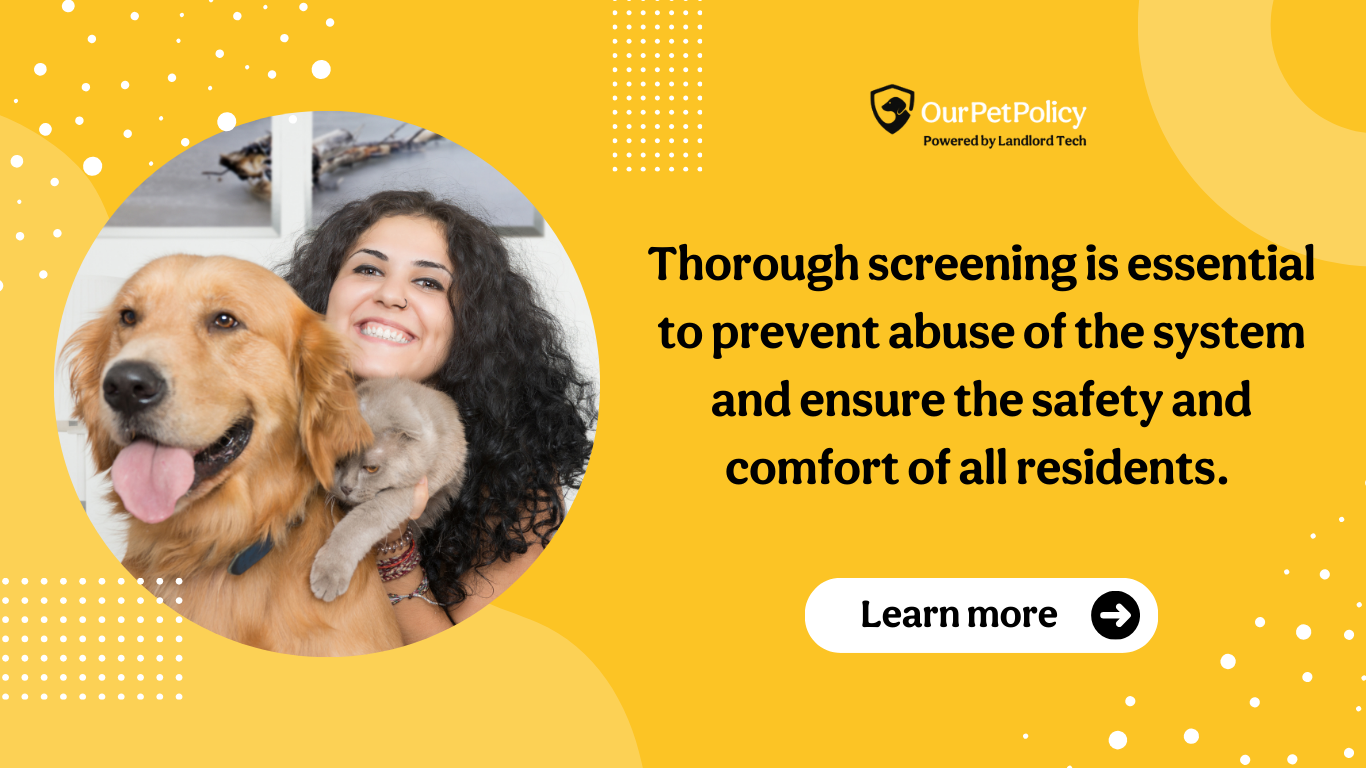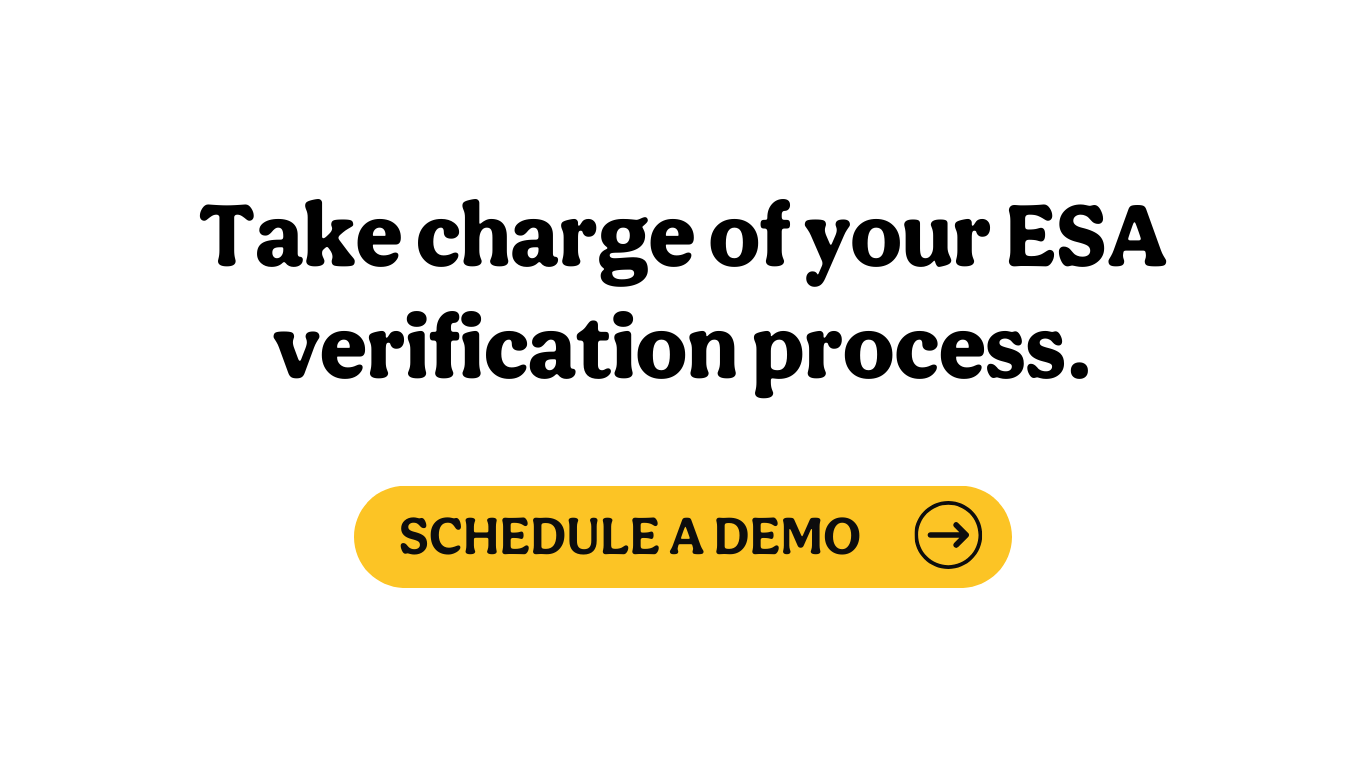It’s estimated that nearly a third of Americans who own pets have had a pet certified as an emotional support animal (ESA). As this number grows, landlords and property managers continue to grapple with regulations protecting ESAs while doing their best to ensure a positive living environment for all residents on the property.
When renters present a pet as a service animal, it’s important to take the request seriously and ensure that proper procedures are followed. This starts with verifying that the ESA claim is legitimate and the paperwork is valid. In recent years, technology has made it possible to streamline this process, helping ease the burden on property teams.
This post details exactly how technology can support ESA verification and why now’s the time to invest in pet screening software for your rental property.
The Challenges of ESA Verification
Verifying the legitimacy of an emotional support animal is a complex process involving an assessment of an individual's mental health needs and the legitimacy of their pet’s role in supporting them. This process, however, is a necessary evil. Thorough screening is essential to prevent abuse of the system and ensure the safety and comfort of all residents. Without proper verification, there's a risk of allowing untrained or potentially aggressive animals on the property, which can put residents and staff at risk.
Property managers who have had to manually verify ESAs know that it’s a daunting task. Between reviewing paperwork, following up with healthcare professionals, and ensuring regulations are followed, the process can drag on and is susceptible to delays and errors. Pet screening solutions ease these burdens by ensuring accuracy and saving valuable time and resources.
The Benefits of Technology in ESA Verification
Technology offers several benefits over manual verification of emotional support animals. In addition to automating and streamlining the process of pet verification, the right pet management software can also support documentation management. Given the strict laws governing service animals, it’s important to have paperwork at your fingertips for easy reference as needed. This also helps prevent physical certificates from being forged or lost.
Additionally, residents can upload documentation, and property teams can save, review, and store the information as part of the screening process. The resident can also be continuously updated as needed as the verification proceeds.
Technology-driven solutions can also help property managers stay up-to-date with changing ESA laws and regulations, reducing the risk of legal issues and ensuring that residents' rights are respected.
OurPetPolicy actually assumes liability themselves for property management by accepting or denying ESA applications.
Features of Pet Management Software
More and more landlords are choosing to optimize ESA verification by investing in pet management software. The benefits are evident at every step of the process. When a resident presents a service animal for review, they can easily submit all necessary documentation via an online form. This helps reduce physical paperwork and ensures digital capture and storage of documents. Once documents are received, they can be verified via an integrated database of licensed healthcare professionals. This feature helps facilitate swift and accurate assessments, ensuring that only legitimate ESAs are approved.
Customizable screening options can also be set, ensuring that all applications are reviewed fairly and lawfully using the same set of criteria. Finally, after pets are reviewed, all information that has been collected in support of an ESA application is stored in a centralized database. This allows for easy reference and review should documentation need to be provided during legal challenges or other instances.
Streamlining the Resident Experience
The ESA verification process can be stressful and confusing for not only property managers but residents as well. In manual processes, residents are often left out of the loop wondering whether their pet will be accepted under ESA guidelines.
Making the process seamless for residents and providing full transparency can help improve satisfaction and retention rates. Residents will be more likely to feel heard and valued, helping to foster trust in property management and create a more harmonious living environment. This ultimately benefits property teams, residents, and the furry companions who live in the community.
By utilizing pet management software with an integrated resident portal, renters will be able to easily submit documents and communicate directly with management to understand where they are in the process.
The Future of ESA Verification: Investing in Pet Management Software
The benefits of using pet management software as part of your ESA verification program cannot be overlooked. Not only can these platforms more efficiently and accurately validate service animal requests, but they can also ensure your property remains compliant with regulations and residents remain informed throughout the process.
Applications such as OurPetPolicy offer an off-the-shelf solution to help you seamlessly manage your pet program. With a suite of useful features, an investment in pet management software can yield substantial returns.
Between improved efficiency in the verification process and reduced administrative burdens, these tools can help increase tenant retention, reduce legal exposure, and offer an enhanced community experience.
Bottom Line
If your property team is bogged down in paperwork and complexity around pet screening, now’s the time to consider more practical alternatives. Pet management programs such as OurPetPolicy offer modern solutions to help you overcome the administrative headaches of emotional support animal verification while offering residents a more practical, seamless process to submit documentation and stay up to date.
And now you can get started with a free ESA verification from OurPetPolicy! Run one verification through the platform to see just how simple it is to validate an ESA claim, store documentation, and communicate with residents.


